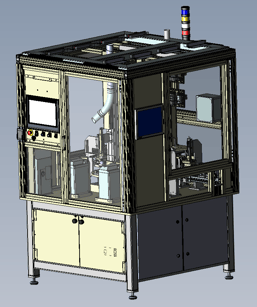Shorter time-to-market with digital twin prototyping and virtual commissioning.
In this blog post: We are employing digital twin prototype and virtual commissioning technology to run extensive testing on new machines – long before they are built.
Digital twin technology began its life as very sophisticated – and very costly – experiments done by organizations such as NASA, but the advent of simulation software has made digital twin technology more widely accessible.
In short, a digital twin prototype is a computer rendition of a working machine that can be put to work on virtual components. Using a digital twin prototype, a producer of machines can run a test program and virtual commissioning that will demonstrate how the machine works once it is built. The idea is to eliminate errors and shorten commissioning time once the machine is ready to go into operation.
This video shows various functions of the machine as a virtual installation
Building a digital twin prototype
Our first innovation project using digital twin prototyping technology and virtual commissioning has just been completed. The machine in question was developed for and in collaboration with Danfoss. The machine, amongst other processes, performs engraving operations on all four sides of a component before handing it on to the next process in line. Based on CAD drawings, a fully functioning yet digital twin prototype of the machine is constructed and can be tested as in real life.
 The CAD model of the machine is processed in specialized software that can then simulate the operation of all moving parts and sensors of the machine and the motion of the components to be engraved. The simulation even shows the green laser ray, simulating that the engraving is being done, making it possible for our engineers to precisely see how everything will work together once the machine is built.
The CAD model of the machine is processed in specialized software that can then simulate the operation of all moving parts and sensors of the machine and the motion of the components to be engraved. The simulation even shows the green laser ray, simulating that the engraving is being done, making it possible for our engineers to precisely see how everything will work together once the machine is built.
At the operating display, alarms and operation of the machine are shown, and the operator can use the actual physical interface of the machine to control the simulated machine.
Cutting commissioning time and time-to-market
Jakob Nors, innovation manager at PJM, explains:
“We are now capable of constructing a fully working digital model or selected critical parts of machines that we build. We can design and to a large extent test the software and the user interface as well, and this means that we can now model how the machine will run, long before it is built. By doing so, we can cut the in-house physical commissioning time– because we will have verified correct functionality in the digital model in advance.”
At PJM, we expect to expand this technology to become part of our frontend design processes – which means that we can offer our customers the possibility of virtual testing as a part of the development process.
Advantages:
- Thorough test of program can be run before the machine is built
- Desktop testing of user interface based on the real PLC program and simulated components
- Earlier start of commissioning phase means shorter time-to-market
- More flexibility in planning of software resources throughout a project
- Better time to fix possible bugs before commissioning begins
Comments or questions?
Please feel free to drop us a line.
